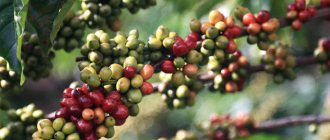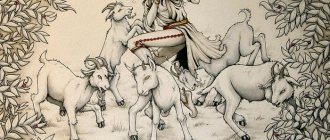Legends about the origin of coffee
In nature, coffee trees and shrubs still grow in the highlands of Ethiopia, Kenya and Sudan. The proof of the origin of coffee is in its name. Interestingly, Ethiopians themselves call coffee “bun” or “buna”. But the word “coffee” entered the lexicon of all other peoples - in honor of Kaffa, one of the Ethiopian provinces. However, according to another theory, the name of the drink comes from the Arabic “qahwa” - “dispelling sleep”.
Observant shepherd
The most popular legend says that in the 9th century, a shepherd from Kaffa named Kaldim noticed that his goats, having tasted the leaves and fruits of a certain nameless bush, became especially vigorous and cheerful. Kaldim also decided to try these berries, after which he could not sleep for a day. Considering this a gift from heaven, the shepherd took the berries to the abbot of the local monastery, since the monks, who devoted themselves to fasting and prayer day and night, needed reinforcement of strength like no one else.
Burning Forest
According to another version, one day a coffee grove caught fire next to an Oromo village. But what was the surprise of people when it turned out that burning coffee fruits emit a pleasant aroma! This is how the tradition of roasting coffee beans was allegedly born.
Exiled Sheikh
In Ethiopia they like to tell the tale of Sheikh Omar, who, for freethinking, was exiled to the desert, to certain death from hunger, along with his disciples. The ruler was shocked when a year later it was discovered that Omar and his followers, who ate coffee beans, had survived.
Where and when did coffee appear?
Legends say that the homeland of the coffee tree is in Ethiopia, and the first mentions in scientific treatises date back to the 5th century. They say that at that time there lived a shepherd Kaldim who discovered the grains. The goats he was looking after took a liking to the evergreen bushes with reddish berries, and they began to eat them.
- Don't miss: How a coffee tree grows in nature
The shepherd noticed that after such a meal the goats become more active and playful. So I decided to try the berries myself. They turned out to be tasteless, but gave tired Kaldim strength and vigor. He told the abbot of the monastery about this, who decided to give a decoction of the plant to the monks so that they would not fall asleep during a long service. Gradually, residents of the surrounding area began to show interest in the invigorating elixir.
According to another legend, coffee was invented by an Ethiopian doctor. Having discovered a tree with fragrant bushes, he made a decoction from the seeds and leaves. After drinking a little, the doctor felt a surge of energy and began to experiment. He added healing infusions to the broth, and with the resulting drugs he cured even seriously ill patients. The author kept the recipe for the miraculous elixir secret until the end of his life and only before his death he told his son about it.
According to another version, Sheikh Omar found coffee when he was in exile and hiding in a cave. Waking up in the morning, he heard the singing of a beautiful bird and followed its voice. Seeing the fragrant tree, the sheikh could not resist. Having once tasted a decoction of wonderful berries, he fell deeply in love with this taste.
- This is interesting: Unknown and interesting facts about coffee
The history of the origin of coffee is also connected with the Archangel Gabriel. Traditions say that with the help of coffee decoction in Ethiopia, he healed the dying Muhammad, who was not helped by any other means. An unusual black elixir restored vitality and clarity of mind to the patient.
The history of coffee cultivation begins in the 7th century. in the territory of modern Yemen. At first, grains were simply boiled, crushed and added to food. We also tried making tinctures with water. In the 12th century. plantations appeared here. For almost 200 years, this country was the main supplier of coffee to the entire East.
Coffee in Arabia
Judging by the treatises of Arab and Persian scientists, people knew about the healing properties of coffee beans even before our era. But a medicinal infusion made from raw beans is one thing, a drink made from roasted coffee that brings pleasure is another.
The first mention of coffee made from roasted beans is contained in a 16th-century treatise written by Abd al-Qadir al-Jaziri. According to the scientist, in 1454, Sheikh Jamal al-Din al-Dhabhani, who was at that time the Mufti of Aden, tasted the drink.
Enterprising Yemeni merchants appreciated the prospects for coffee and set up the first plantation. Coffee grown in Arabia came to Cairo, Damascus, Baghdad, Mecca and Medina, and later to the Maghreb countries (Tunisia, Libya, Algeria, Morocco). The export of unroasted grains was strictly prohibited. The main trade was carried out through the port of Al Mokha - this is how the name “Mocha” was born.
Even Islam couldn't overcome the Arabs' love of coffee.
However, Muslim theologians have taken up arms against the invigorating drink: the Koran strictly forbids adherents of this religion from consuming brain-stupefying substances. In 1511, a council of theologians in Mecca declared coffee to be the devil's potion and cursed it in the name of Allah. Egyptian coffee lovers of those times had their tongues torn out, and those who persisted in heresy were drowned in the sea, having previously been sewn into coffee bags.
Coffee countries
We already know that Africa is considered the birthplace of coffee. Since there are many varieties, they are not all from Ethiopia.
Liberia is a coffee variety that was originally grown in the African country of the same name Liberia. Over time, grains of this variety began to be produced in other countries.
Yemen is considered the birthplace of such a variety as mocha. They call it that because its origin is from the city of Moha. This area is dominated by soils with a special composition, and the grains grown on these lands are moderately acidic. And the soils in American and African countries have high acidity, and the taste of the brewed drink from these grains is sour.
Coffee in Turkey
Real success awaited coffee in Turkey, where it arrived in the 16th century. The Turks were already familiar with the taste of the drink, but it was not particularly popular among the nobility. Everything changed when, in the middle of the 16th century, the governor of Yemen, Ozdemir Pasha, brought coffee beans as a gift to Sultan Suleiman the Magnificent.
The ruler and his beautiful wife Hurrem (who went down in history under the name Roksolana) liked the drink so much that drinking coffee soon became fashionable at the Turkish court. As usual, fashion moved from palaces to squares, and in 1564 the first coffee shop was opened in Istanbul. Visitors engaged in philosophical debates and discussed the latest news.
The Turks turned the process of brewing coffee into a high art and brought it to perfection. The drink for the Sultan was prepared and served by 40 servants. Soon the ability to brew coffee began to be considered one of the virtues required for any self-respecting bride.
Coffee house from the Ottoman Empire
What is better coffee or cocoa
Cocoa is also considered an invigorating drink and is very popular among many. South America is considered the birthplace of cocoa. It contains an element such as phenylethylamine, which produces the joy hormone endorphin. The drink is also rich in zinc, iron and folic acid. Melanin, which is also part of cocoa, has a beneficial effect on skin condition. Caffeine is contained in the drink, but in an amount that does not harm the body.
Although cocoa is high in calories, you will not gain excess weight, because after the first cup you drink, you will feel full.
Coffee and cocoa have many differences, but they are both delicious, and it is impossible to say for sure which one brings more benefits. When choosing a drink, it should be taken into account that people with cardiovascular diseases are better off drinking cocoa, while coffee can be drunk by those who want to lose weight and do not have health problems.
Coffee in Italy
The first European country to embrace the coffee fashion was Italy. In those days, on its territory there were several fairly strong city-states that were always at war with each other.
Already from the middle of the 16th century, Genoese and Venetian merchants, who traded throughout the Mediterranean and maintained trade relations with the Sublime Porte, brought aromatic grains for personal use. Merchants and travelers in the Middle Ages were always a bit of a spy, and therefore showed special observation. The embassies included scientists whose task was to describe the life and customs of the countries visited.
Europe first learned about coffee from a fascinating book by the Genoese Antonio Menavino, published in 1548. At the age of 12, in 1504, Messer Antonio was captured by Corsican pirates, who sold him into slavery. A handsome and smart boy was presented to the Sultan, and after 10 years the prisoner managed to escape. Subsequently, Menavino described everything he saw in Turkey, mentioning coffee.
The world's first coffee machine by Luigi Bezzera
In 1591, the Paduan physician and botanist Prospero Alpini wrote an entire book dedicated to coffee. Alpini spent several years at the embassy in Egypt, where by that time the laws against coffee drinkers had been significantly relaxed. The scientist not only learned about the properties of aromatic grains, but also carefully wrote down the recipe for the drink.
The first Italian coffee shop opened in Venice in 1615. She was extremely popular. Artists and poets flocked to the aroma of coffee like bees to honey.
The Pope's ambassador to Persia, Pietro della Valle, confessed his love for coffee. It is believed that he spoke so captivatingly in salons about the East and the love of the local inhabitants for coffee that he intrigued the entire Roman high society. Already in 1626, the first coffee shop opened in Rome, and then coffee establishments began to appear throughout Italy.
Subsequently, Catholic priests, dissatisfied with the passion of their flock for an invigorating drink, turned to Pope Clement VIII with a request to ban coffee. But the Pope, having tasted the coffee, came to the conclusion that this little joy for the parishioners was forgivable.
There are four main types of coffee, not two.
Arabica, Robusta, Liberica and Excelsa: four types of coffee that grow on the globe
There are four varieties of coffee trees in the world. The most common is Arabica (Arabic coffee). It occupies about 70% of the world market and is considered a leader. It has a rich coarse aroma, a pleasant strong taste with bitterness. Often used to prepare coffee blends or instant granules.
Robusta is another variety of coffee trees, significantly inferior in production to Arabica. It has a sour aroma, refined taste, and slight sweetness. Used in pure form or in mixtures with Arabica.
The most popular Arabica coffee has a rich, bright aroma and a pleasant, strong taste with a hint of bitterness.
Two more types of varieties, less known, are Excelsa and Liberica. They have much in common with Robusta, but are significantly inferior in taste. They are used to give the drink strength and lasting aroma.
Coffee in France
Most likely, the first coffee came to France at the beginning of the 17th century through Marseille, but the fashion did not reach Paris. But in 1664, the entire French capital was gossiping about the receptions hosted by the envoy of the Sublime Porte, Suleiman Mustafa Agha. The gallant gentleman and witty interlocutor charmed the entire court of Louis XIV. At receptions, guests were, of course, treated to coffee, and soon word of the unusual drink reached the king himself.
Louis XIV was delighted with the unusual taste and luxurious aroma. And Suleiman Mustafa Agha only grinned through his bushy mustache: the new fashion promised considerable profits to Turkish merchants, and the gentleman ambassador was clearly in their share.
True, things did not get better right away. While the nobility admired the Turkish drink, the townspeople of Paris, accustomed to sweets, were not particularly enthusiastic. The Armenian Pasquiali Kharakyan, who opened a coffee shop on Saint-Germain Street, went bankrupt and left for England.
But the Italian Procopio Cuto took into account the mistakes of his predecessor. At his establishment, opened in 1684, coffee was served with freshly baked croissants topped with sweet syrup. This coffee shop is still in operation; it is located opposite the Comedie Française theater.
Coffee in the French colonies
The first coffee plantation in the French colonies was established on the island of Bourbon (Reunion). But until the beginning of the 18th century, no one even tried to plant coffee trees in the French Antilles. And there are almost ideal conditions for coffee: mountainous terrain, suitable climate. The history of the appearance of coffee in the Antilles is similar to an adventure novel.
Back in 1814, the mayor of Amsterdam presented a coffee seedling to King Louis XIV, who, thanks to the light hand of the Turkish envoy, became addicted to the invigorating drink. A year later, the king died, and the Regency era began in France, known for freedom of morals and oblivion of the reasonable policies of the former king.
A coffee seedling planted in the Botanical Garden turned into a regularly fruiting tree, from which beans were collected especially for the young King Louis XV.
A young naval officer, Gabriel de Cleux, believed that coffee could be grown in the New World. But de Cleux was unable to convince the authorities of the prospects of this idea. Then the young man made an agreement with his friend, with whom the court doctor, who had access to the greenhouse, was in love. At the lady's request, a loyal admirer stole several tiny coffee seedlings, and she gave them to the Chevalier de Cleux.
Gabriel de Cleux tries to save the coffee tree
Having carefully packed the precious sprouts, Gabriel set off for Martinique on the sailing ship Dromedary. On the way, the ship was attacked by pirates and, although the crew managed to fight back, the water supplies were seriously damaged. The water requirement was reduced to a minimum.
Suffering from thirst, Gabriel gave most of his meager rations to the last, already withering coffee seedling. A miracle happened: both de Cleux and the tree reached Martinique alive in 1723. From this seedling came all the coffee trees on numerous plantations in the Antilles.
Traditions and customs associated with coffee and the coffee tree
Since the history of the emergence and development of coffee culture has been going on for several hundred years, unique traditions and customs are associated with the coffee tree and the drink obtained from its beans in many countries. We will tell you about some:
- In Ethiopia, a guest who comes to the house is treated to coffee. In this case, the owner of the home must brew the drink, and in his absence, the eldest son. The guest cannot refuse the treat - this is considered an insult to all family members.
- In Iraq, it is considered indecent to drink more than three cups of drink a day - such excess is condemned by society and is considered a sign of addiction.
- Japan did not recognize the drink for a long time, since the tea tradition is strong in this country. Now you can drink a cup of espresso or cappuccino in any cafe, but residents of the country to this day do not like strong varieties, preferring soft roasting.
- In Turkey, for several centuries, a girl’s ability to conduct a coffee ceremony according to all the rules was considered one of her most important advantages at the brides’ fair.
Coffee in Brazil
While the Spaniards, Dutch and French sought to overtake each other in the “coffee race,” vast territories of Portuguese-owned Brazil lay empty. Neither the French nor the Dutch were in a hurry to share precious seeds with their competitors.
But in 1727, Portuguese lieutenant Francisco de Mello Paleta went to French Guiana as part of a diplomatic mission. It later became clear that the authorities set the officer a task: to obtain coffee seeds or seedlings at any cost.
At a dinner at the house of the governor of Cayenne, Count d'Orvilliers, Don Francisco asked for a few grains of coffee. A decisive refusal followed: Admiral d'Orvilliers also had superiors, and they forbade the transfer of coffee beans to the Portuguese. After lunch, the governor's wife went to show Don Francisco the garden. The young officer managed to charm the ardent Frenchwoman, and at parting she threw several treasured grains into his pocket.
Harvesting coffee beans on a plantation in Brazil in 1750
The Portuguese was shocked, but Madame Countess with a sweet smile said that her husband was a military man and was obliged to follow orders, but she was free to give anything to those she liked. Today, Brazil produces about a third of the world's coffee, far ahead of its competitors.
But the continuation of the history of coffee in Brazil was not so romantic. Millions of black slaves worked for the benefit of the haciendeiro. And when slavery was abolished in Brazil in 1888, causing plantation owners to go bankrupt, the government passed laws promoting immigration. At the end of the 19th century, the situation of Italians who came to Brazil was not much different from slavery. Immigrants worked for barely a piece of bread. Even now, the situation of agricultural workers in Brazil leaves much to be desired.
Production
Ethiopia ranks first in coffee production in Africa and fifth in the world. About half of the products are exported, the rest is sold on the local market.
Ethiopia is literally made for growing coffee: it has ideal weather conditions, fertile soil, and a suitable climate. Most coffee will grow in natural conditions: among other plants, in the shade of trees, without the use of fertilizers or chemicals.
This is the only country where coffee trees are not only cultivated on plantations, but also found in the wild.
Production methods have not changed much over the past hundreds of years: coffee in Ethiopia is still planted, cultivated, harvested and dried primarily by hand. The approximate area of all land allocated for coffee farming is 4000 m² - it is difficult to calculate more precisely, because we are not talking about large plantations, but about many small farms.
Kings vs coffee
Not all European monarchs loved coffee. For example, Charles II Stuart banned coffee houses in 1675. The formal reason was a petition from English ladies who claimed that their husbands had become indifferent to love pleasures, since they were not interested in anything other than coffee.
English coffee house from 1674
However, by that time English coffee houses had turned into political clubs. The owners of coffee shops printed pamphlets directed against the monarch and distributed them to visitors. Paid servants and petty clerks raced to deliver news from parliamentary sessions to coffee shops. Remembering the fate of his father who died on the chopping block, Charles II chose to strangle the nests of ripening riots and issued a decree banning coffee houses.
The Swedish kings of the 17th and 18th centuries also did not have warm feelings for coffee, so they imposed huge taxes on its consumption. Naturally, there were always clever people who bought grains from smugglers, but those who brewed the drink without paying the tax were mercilessly fined.
In Reval (Tallinn), which belonged to Sweden at the beginning of the 18th century, soldiers were on duty day and night on one of the highest towers. They had two tasks: to warn citizens about a fire and to sniff the smoke from the chimneys. A patrol was sent to the house, which smelled of freshly brewed coffee, to check whether the owners had paid the tax.
How did the coffee drink become popular?
Another important date for the spread of coffee to Europe is 1683, the second year of the Siege of Vienna by the Turks and the final expulsion of the Ottomans. The invaders are said to have left behind bags of mysterious dark grains. Only a Pole named Kulczycki knew them: he had lived for some time in the territory of the Ottoman Empire, and so he realized that he had found a very valuable supply of coffee. Thus, when the war ended, he opened a store in Vienna, where he sold bitter coffee, as well as coffee mixed with milk and honey, called Viennese coffee.
From Vienna and Venice, coffee soon spread throughout Europe, with some of the most famous cafés being established. And from these European countries, coffee culture spread to other regions.
Coffee in Russia
In 1665, the court doctor prescribed Tsar Alexei Mikhailovich to drink coffee to get rid of a runny nose and headache. But the tsar’s son, Emperor Peter I, became addicted to the aromatic drink in his youth, having made friends with foreigners who lived in the German settlement.
Peter the Great was a coffee lover
Upon returning from Holland, the emperor began with an iron fist to force his subjects to share his passions. According to contemporaries, Peter I could appear at the house of any of the nobles at any time of the day or night and demand a cup of coffee. The drink was always served at the assemblies that became fashionable. In 1724, in St. Petersburg, at the behest of the emperor, 15 taverns were opened for foreigners, where they served coffee.
The niece of Peter I, Anna Ioannovna, loved coffee in the same way. Under her rule, the first Coffee House was opened in St. Petersburg in 1740. But, although both Elizabeth and Catherine II had a passion for coffee, until the Patriotic War of 1812, the drink remained a whim of the highest nobility. He gained real popularity in Russia after the victory over Napoleon, when the Russian army returned from Paris. Since then, coffee has become a frequent guest in the estates of small nobles, and in merchant houses, and even in the apartments of commoners.
Brazilian coffee recipe
Residents brew a delicious sweet drink that everyone will enjoy. To prepare it you will need the following ingredients:
- A teaspoon of ground coffee beans;
- Fifty grams of dark chocolate;
- Two cups of hot milk;
- Whipped cream;
- Sugar.
First, brew the coffee and strain it, add the chocolate pieces. Pour this mixture into a large container, pour in hot milk and beat well with a mixer. Now add sugar to taste, pour into cups and garnish with whipped cream.
Healthy Arabica
It is important to pay attention to the smell: this variety differs from others in its rich and bright aroma.
Natural, fresh coffee benefits the body.
- Coffee gives you energy and joy, as caffeine increases dopamine levels. Even the smell of coffee alone stimulates the production of pleasure hormones.
- Caffeine not only improves mood, but also stimulates mental work, helping to concentrate, sharpens attention and reaction.
- Caffeine dilates blood vessels, this helps when you need to relieve muscle spasm, for example, with a headache.
- Caffeine stimulates blood circulation. Consuming coffee in reasonable quantities has a beneficial effect on the functioning of the cardiovascular system. Optimal caffeine content in Arabica. But you need to be careful with Robusta, as it has a high caffeine content.
- The antioxidants and phytonutrients found in grains may reduce the risk of developing chronic diseases. They also contribute to the destruction of abnormal, that is, cancerous, cells in the body.
- Lipids contained in coffee beans are a source of energy for cells and improve the absorption of vitamins. By the way, Arabica contains almost twice as many lipids as Robusta.
All the benefits of coffee can only be achieved if you drink it within reasonable limits. A reasonable amount is 1–2 cups of coffee per day. Of course, besides the benefits, coffee also has a downside.











